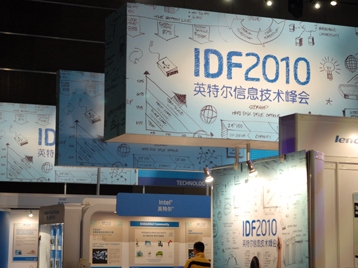Intel shows off Queensbay SoC
Integrated system-on-chip runs newly named MeeGo OS

Intel has previewed its upcoming 'Tunnel Creek' System-on-Chip (SoC) tech for in-vehicle-infotainment systems for cars. Interestingly, the demo - on a vehicle designed by Chinese car maker HawTai and based on the Queensbay platform - was running MeeGo, Intel's now joint venture OS with Nokia.
The forthcoming SoC hardware features an Intel Atom processor core that will directly connect to other third-party devices via the PCI Express standard, saving on cost. Queensbay is, essentially, a later version of the company's Menlow platform.
The Tunnel Creek SoC combines the processor core, memory controller hub, graphics engine and video engine into one chip and because of the PCI Express compatibility could link to other technologies such as Nvidia's Ion graphics chip. The hardware could also be used for other applications such as IP telephony, says Intel.
Dian Ming, vice chairman of HawTai Automotive, was predictably enthusiastic about the new hardware. "It saves us application development costs, and enables new services to be introduced quickly with high reliability."
"With an infotainment solution that utilises the Intel Atom processor, we are leveraging the well-established and latest internet technologies, and re-using existing software that has been developed on [the] MeeGo based Linux platform," said Mr Wang.
Frugal power use
Energy efficiency is another key theme of this IDF. Intel Chief Technology Officer and managing director of Intel Labs, Justin Rattner, discussed how smarter technology can reduce and better manage energy consumption.
Sign up for breaking news, reviews, opinion, top tech deals, and more.
"Consumer empowerment is critical," said Rattner. "If we can make energy more personalised with real-time information and offer visual tools that engage entire communities, it will lead to valuable changes in behavior and save staggering amounts of energy."
Intel researchers have invented a new wireless device to make the collection of energy data easy and inexpensive for consumers. The experimental sensor needs to be plugged into your home's electrical wiring to measure and wirelessly report the power consumption of each electrical load.
Intel has also been talking up the "connected computing experience" where all devices share information (if only).
"With an additional 1 billion connected computing users by 2015 and with more types of devices there is value in providing a common experience between the devices," said David (Dadi) Perlmutter, executive vice president and co-general manager, Intel Architecture Group.
"Intel architecture delivers the right combination of performance and power that provides the foundation across all computing devices creating a virtual continuum of computing to enable this common user experience."
Dan (Twitter, Google+) is TechRadar's Former Deputy Editor and is now in charge at our sister site T3.com. Covering all things computing, internet and mobile he's a seasoned regular at major tech shows such as CES, IFA and Mobile World Congress. Dan has also been a tech expert for many outlets including BBC Radio 4, 5Live and the World Service, The Sun and ITV News.